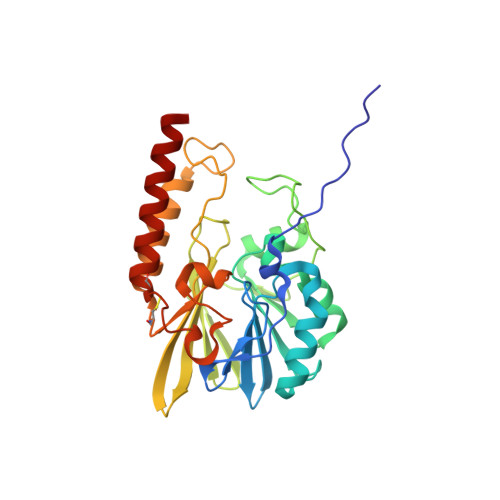1,2,4-Triazole-3-thione Compounds as Inhibitors of Dizinc Metallo-beta-lactamases.
Sevaille, L., Gavara, L., Bebrone, C., De Luca, F., Nauton, L., Achard, M., Mercuri, P., Tanfoni, S., Borgianni, L., Guyon, C., Lonjon, P., Turan-Zitouni, G., Dzieciolowski, J., Becker, K., Benard, L., Condon, C., Maillard, L., Martinez, J., Frere, J.M., Dideberg, O., Galleni, M., Docquier, J.D., Hernandez, J.F.(2017) ChemMedChem 12: 972-985
- PubMed: 28505394
- DOI: https://doi.org/10.1002/cmdc.201700186
- Primary Citation of Related Structures:
5DPX - PubMed Abstract:
Metallo-¦Â-lactamases (MBLs) cause resistance of Gram-negative bacteria to ¦Â-lactam antibiotics and are of serious concern, because they can inactivate the last-resort carbapenems and because MBL inhibitors of clinical value are still lacking. We previously identified the original binding mode of 4-amino-2,4-dihydro-5-(2-methylphenyl)-3H-1,2,4-triazole-3-thione (compound IIIA) within the dizinc active site of the L1 MBL. Herein we present the crystallographic structure of a complex of L1 with the corresponding non-amino compound IIIB (1,2-dihydro-5-(2-methylphenyl)-3H-1,2,4-triazole-3-thione). Unexpectedly, the binding mode of IIIB was similar but reverse to that of IIIA. The 3?D structures suggested that the triazole-thione scaffold was suitable to bind to the catalytic site of dizinc metalloenzymes. On the basis of these results, we synthesized 54 analogues of IIIA or IIIB. Nineteen showed IC 50 values in the micromolar range toward at least one of five representative MBLs (i.e., L1, VIM-4, VIM-2, NDM-1, and IMP-1). Five of these exhibited a significant inhibition of at least four enzymes, including NDM-1, VIM-2, and IMP-1. Active compounds mainly featured either halogen or bulky bicyclic aryl substituents. Finally, some compounds were also tested on several microbial dinuclear zinc-dependent hydrolases belonging to the MBL-fold superfamily (i.e., endonucleases and glyoxalase?II) to explore their activity toward structurally similar but functionally distinct enzymes. Whereas the bacterial tRNases were not inhibited, the best IC 50 values toward plasmodial glyoxalase?II were in the 10?¦Ìm range.
Organizational Affiliation:
Institut des Biomol¨¦cules Max Mousseron, UMR5247 CNRS, Universit¨¦ de Montpellier, ENSCM, Facult¨¦ de Pharmacie, 15 avenue Charles Flahault, 34093, Montpellier cedex 5, France.



















